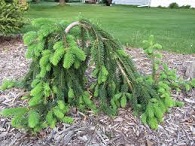Can’t Find a Weeping Norway Pine? Read our guide for facts & information on why finding a weeping Norwegian pine is so difficult…
Gardeners looking for a weeping Norway pine tree are out of luck since there is no weeping Norway pine. There is a weeping Japanese pine or a weeping Norway spruce, but the Norway pine is not a weeping tree. Weeping trees are characterized by branches that arch downward and both the weeping Norway spruce and the Japanese pine have low branches which grow at ground level.
Weeping Evergreens
The choice of a weeping evergreen tree depends on the size of a garden and the area where the tree will show to best advantage. Weeping trees are great ornamentals but while the Japanese red pine grows to a height of about two feet, with training the Norway weeping spruce may grow as tall as six feet. Without training, the weeping Norway spruce remains low to the ground and may be used as a ground cover. Other weeping evergreens include the weeping cedar of Lebanon, the weeping Serbian spruce and the weeping blue spruce. Most varieties of cedar tree are difficult to grow. The weeping Serbian spruce is a good choice for small spaces reaching a height of six to eight feet with a diameter of only two to three feet.
The Weeping Norway Spruce and the Weeping Blue Spruce
These weeping evergreens are especially hardy and grow well in U.S. zones 2 through 7. The blue spruce cannot be trained as an upright while the weeping Norway spruce can be staked and will reach an upright height of about six feet. Both weepers can be used as a ground cover and the Norway spruce will reach a diameter of between ten and fifteen feet at maturity. In contrast, the diminutive Japanese weeping red pine only reaches a diameter of about five feet. As with most spruce trees both blue and Norway varieties prefer full sunlight and mildly acidic soil.
A Spruce Is Not a Pine Tree
Many homeowners who have failed to research plants confuse the weeping Norway spruce with pine trees. While both spruce and pine trees are evergreen conifers with needles rather than leaves, they are completely different species. Pine tree needles grow in bundles of 4 or 5 while spruce needles grow independently. Pine tree needles are round and spruce needles are four sided, roughly square in a cross section. Other common evergreens include the fir tree which has flat needles and the juniper and cedar which have softer lacy needle formations.
While gardeners may search in vain for a weeping Norway pine, the weeping Norway spruce is an interesting and low maintenance addition to any garden. It is versatile and can be used in rock gardens or as an ornamental and keeps some green in the garden throughout the year.





